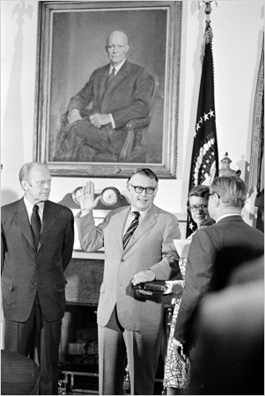Colgate alumnus H. Guyford Stever, 93, the top science adviser to two presidents who led the oversight committee that redesigned the space shuttle’s booster rockets after the Challenger disaster, has died.
News outlets from around the country, including The New York Times and Washington Post, reported on the April 9 death of Stever, who graduated from Colgate in 1938.
According to the Post, as chief scientist at the U.S. Air Force, Stever helped establish NASA in the late 1950s and he was a key player in the nation’s space program a generation later.
After the space shuttle Challenger exploded in 1986, killing all seven crew members, Stever was appointed by the National Research Council to lead the 10-member panel of experts who served as independent watchdogs over the rebuilding of the shuttle’s booster rockets. It was a technically complex and politically sensitive job.
 |
| H. Guyford Stever becomes director of the Office of Science and Technology in 1976 under President Gerald R. Ford. (Photo courtesy of The New York Times) |
His leadership in that successful endeavor, as well as others, helped earn him the National Medal of Science in 1991 and the National Science Board’s prestigious Vannevar Bush Award in 1997.
Stever was born Oct. 24, 1916, in Corning, N.Y., and was orphaned as a boy. He graduated on scholarship from Colgate, and received a doctorate in physics from the California Institute of Technology in 1941.
He contributed to seminal research on radar during World War II and developed international cooperation among scientists in radar and guided missile work, working in Europe to evaluate how far the Germans had developed radar technology.
After the war, he became a professor at the Massachusetts Institute of Technology, then took leave to be chief scientist at the Air Force in 1957.
A month after the Soviet Union sent the Sputnik satellite into orbit, Stever was asked to lead the National Advisory Committee for Aeronautics’ special committee on space technology, which aimed to coordinate federal, educational and private entities to develop an American space program. The panel became known as the Stever Committee.
He became president of the Carnegie Institute of Technology in Pittsburgh in 1965 and two years later led its merger with the Mellon Institute of Research, becoming Carnegie Mellon University.
He led the school until 1972, when he became director of the National Science Foundation and also science adviser to President Richard M. Nixon.
Nixon abolished the White House Office of Science and Technology three years later, but when Congress reestablished it in 1976, President Gerald R. Ford asked Stever to return to lead it.
In his time at the National Science Foundation and the White House, the journal The Sciences said in 1976, “Stever has been the conscientious shepherd of the American scientific community during a time when zealots in and out of the community have been afire with wildly conflicting schemes concerning the scope, role and responsibilities of science.”